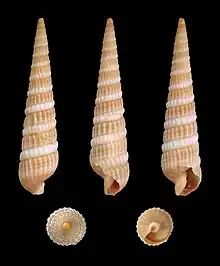| Neoterebra dislocata | |
|---|---|
 | |
| Scientific classification | |
| Domain: | Eukaryota |
| Kingdom: | Animalia |
| Phylum: | Mollusca |
| Class: | Gastropoda |
| Subclass: | Caenogastropoda |
| Order: | Neogastropoda |
| Family: | Terebridae |
| Genus: | Neoterebra |
| Species: | N. dislocata |
| Binomial name | |
| Neoterebra dislocata (Say, 1822) | |
| Synonyms[1] | |
Neoterebra dislocata, common name the eastern auger, is a species of sea snail, a marine gastropod mollusk in the family Terebridae, the auger snails.[1]
Description
The eastern auger Neoterebra dislocata measures on average up to 2 1/4 inches in length, with a pointed spire. The color varies but is often a pale grey or tan.
Distribution
Ecology
This species lives in sounds and offshore on shallow sand flats. The shell is commonly found washed up on sound and ocean beaches.
The Atlantic auger is a carnivore, but it lacks the radula and poison gland found in most other augers.
References
- 1 2 MolluscaBase eds. (2020). MolluscaBase. Neoterebra dislocata (Say, 1822). Accessed through: World Register of Marine Species at: http://www.marinespecies.org/aphia.php?p=taxdetails&id=1416382 on 2020-01-25
External links
Wikimedia Commons has media related to Neoterebra dislocata.
- Fedosov, A. E.; Malcolm, G.; Terryn, Y.; Gorson, J.; Modica, M. V.; Holford, M.; Puillandre, N. (2020). Phylogenetic classification of the family Terebridae (Neogastropoda: Conoidea). Journal of Molluscan Studies
- Say, T. (1822). An account of some of the marine shells of the United States. Journal of the Academy of Natural Sciences, Philadelphia. 2(2): 221-248, 257-276, 302-325
- Kiener L.C. (1834-1841). Spécies général et iconographie des coquilles vivantes. Vol. 9. Famille des Purpurifères. Deuxième partie. Genres Colombelle, (Columbella), Lamarck, pp. 1-63, pl. 1-16 [pp. 1-63 (1841); pl. 2-4, 6, 8, 11 (1840), 1, 5, 7, 9-10, 12-16 (1841)]; Buccin (Buccinum), Adanson, pp. 1–112 + table with duplicate page numbers 105-108, pl. 1-31 [pp. 1–64 (1834), 65-104 and 105-108 of table (1835), 105-112 of text (1841); pl. 1-24 (1834), 25-29 (1835), 30-31 (1841); Eburne (Eburna), Lamarck, pp. 1–8, pl. 1-3 [all (1835)]; Struthiolaire (Struthiolaria), Lamarck, pp. 1–6, pl. 1-2 [pp]. 1-6 (1838); pl. 1-2 (1837)]; Vis (Terebra, Bruguière, pp. 1–42 + table, pl. 1-14 [pp. 1–42 (1838); pl. 1-14 (1837)]. Paris, Rousseau & J.B. Baillière
This article is issued from Wikipedia. The text is licensed under Creative Commons - Attribution - Sharealike. Additional terms may apply for the media files.